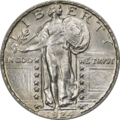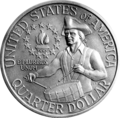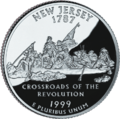Quarter (United States coin) facts for kids
| United States | |
| Value | 0.25 U.S. Dollar |
|---|---|
| Mass | 5.67 g |
| Diameter | 24.26 mm (0.955 in) |
| Thickness | 1.75 mm (0.069 in) |
| Edge | 119 reeds |
| Composition | From 1965: 91.67% Cu, 8.33% Ni 1932–1964: 6.25 grams, 90% Ag, 10% Cu |
| Years of minting | 1796, 1804–1807, 1815–1828, 1831–1930, 1932, 1934–present |
| Obverse | |
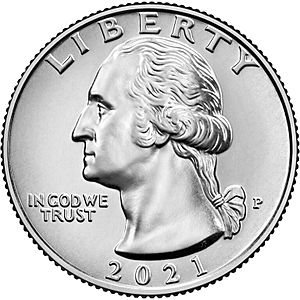 |
|
| Design | George Washington bust |
| Designer | John Flanagan (1932 version) from a 1786 bust by Houdon |
| Design date | 1931 |
| Reverse | |
| Design | George Washington's crossing of the Delaware River |
| Designer | Benjamin Sowards |
| Design date | 2021 |
The quarter, also known as the quarter dollar, is a United States coin. It is worth 25 cents, which is one-fourth of a dollar. This coin is about 0.955 inches (24.26 mm) wide and 0.069 inches (1.75 mm) thick.
On the front side, called the obverse, you'll see the face of George Washington. The back side, or reverse, has had many different designs over the years. Quarters have been made since 1796, with continuous production starting in 1831.
The idea of a quarter coin came from how people used to divide Spanish milled dollars. These dollars were often cut into eight pie-shaped pieces, which is why they were called "pieces of eight." A quarter is like "two bits," meaning two of those eight pieces.
Contents
Understanding the Quarter Coin's Design
The quarter coin you see today is made of two layers of cupronickel (75% copper and 25% nickel) wrapped around a core of pure copper. This mix means the coin is about 8.33% nickel and mostly copper. Each quarter weighs about 0.2000 ounces (5.670 grams).
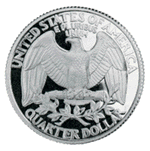
The edge of the quarter has 119 small ridges, called "reeds." When the current type of quarter was first made in 1965, some people called it a "Johnson Sandwich." This was a nickname after Lyndon B. Johnson, who was the US President at that time. In 2011, it cost about 11.14 cents to make each quarter. The U.S. Mint also started making silver quarters again in 1992 for special collector sets. Older quarters, made before 1828, were a bit wider and thinner than today's coins.
George Washington's Image on the Quarter
The regular quarter coin we use now is called the Washington quarter. It shows George Washington on the front. Before 1999, the back of the coin usually showed an eagle. The Washington quarter was designed by John Flanagan. It was first made as a special coin to celebrate an event, but it became a regular coin in 1934.
Special Quarter Programs
In 1999, the 50 State quarters program began. This program created special quarters for each U.S. state. These coins still had Washington on the front, but the back showed a unique design for each state. This program stopped the production of the old Washington quarter design.
Later, in 2007, the program was extended to include the District of Columbia and five U.S. territories: Puerto Rico, Guam, American Samoa, the United States Virgin Islands, and the Commonwealth of the Northern Mariana Islands.
In 2010, a new series called the America the Beautiful quarters program started. This program features designs of national parks and other important sites across the United States. This series is planned to continue for 12 years.
Different Quarter Designs Over Time
Over the years, the U.S. quarter has had many different designs. These designs can be grouped into silver quarters and copper-nickel clad quarters.
Silver Quarter Designs
Silver quarters were made from 1796 to 1964. They were also made for special proof sets from 1992 onwards.
- Wright 1792
- Draped Bust 1796–1807
- Draped Bust, Small Eagle 1796
- Draped Bust, Heraldic Eagle 1804–1807
- Capped Bust 1815–1838
- Capped Bust (Large Size), With Motto 1815–1828
- Capped Bust (Small Size), No Motto 1831–1838
- Seated Liberty 1838–1891
- Seated Liberty, No Motto 1838–1865
- Seated Liberty, With Motto 1866–1891
- Barber 1892–1916
- Standing Liberty 1916–1930
- Standing Liberty (Type 1) 1916–1917
- Standing Liberty (Type 2 or Type 2a) 1917–1924
- Standing Liberty (Type 3 or Type 2b) 1925-1930
- Washington 1932–1964, 1992–1998 (proof only)
- Washington Bicentennial 1975–1976 (all were dated 1776–1976) (40% silver-clad, not for regular use)
- Washington 50 State 1999–2008 (proof only)
- Washington District of Columbia and U.S. Territories 2009 (proof only)
- Washington America the Beautiful 2010–2021 (proof only)
Copper-Nickel Clad Quarter Designs
| Copper-nickel clad copper Washington quarter | |
|---|---|
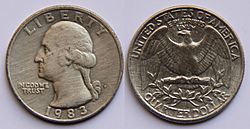 |
|
| Obverse: Portrait of George Washington, year and United States national motto (In God we trust). | Reverse: Bald eagle with wings spread and standing on a shaft of arrows with two olive sprays. Face-value, the motto "E pluribus unum" (Out of many, one) and country name. |
| Total 35,924,089,384 coins minted from 1965 to 1998. | |
These quarters are made of copper and nickel. They were first made in 1965 and are the type we use today for everyday purchases.
- Washington 1965–1974, 1977–1998, 2021
- Washington Bicentennial 1975–1976 (all were dated 1776–1976)
- Washington 50 State 1999–2008
- Washington District of Columbia and U.S. Territories 2009
- Washington America the Beautiful 2010–2021
- Washington (new portrait) Prominent American Women 2022–2025
- Washington Semiquincentennial 2026
- Washington (new portrait) Youth Sports 2027–2030
Special Collector Quarters
Some quarters are made for collectors and are not meant for regular use.
- Isabella quarter 1893
- Gold Standing Liberty quarter 2016
Bullion Quarters
These are special quarters made of precious metals, usually for investors.
- Washington America the Beautiful silver bullion 2010–2021
Collecting Silver Quarters
Silver quarters weigh 6.25 grams and are made of 90% silver and 10% copper. They contain about 0.1808479 troy ounces of pure silver. These were made from 1932 to 1964.
Some silver Washington quarters are quite rare and valuable for collectors. Here are a few examples:
- 1932-D (made in Denver)
- 1932-S (made in San Francisco)
- 1934 – with a "Doubled Die Obverse" (DDO), meaning the design on the front looks slightly doubled.
- 1935-D
- 1936-D
- 1937 – with DDO
- 1937-S
- 1938-S
- 1939-S
- 1940-D
- 1942-D – with DDO
- 1943 – with DDO
- 1943-S – with DDO
- 1950-D/S (a Denver coin with an "S" mintmark underneath)
- 1950-S/D (a San Francisco coin with a "D" mintmark underneath)
Coins like the 1932 Denver and San Francisco quarters are valuable because very few were made. Other coins, like the 1940-D, 1936-D, and 1935-D, are valuable because it's hard to find them in excellent condition.
The "mint mark" on silver quarters tells you where the coin was made. It's found on the back of the coin, below the eagle's wreath. "D" means it was made at the Denver Mint, "S" means the San Francisco Mint, and if there's no mark, it was made at the Philadelphia Mint.
Collecting Copper-Nickel Clad Quarters
The copper-nickel clad Washington quarter first appeared in 1965. In 1968, the "D" mintmark for Denver was added. Before this, the U.S. government was using a lot of silver to make coins, and silver supplies were getting low. To save silver, Congress decided to switch to a new material for quarters: a mix of 75% copper and 25% nickel, with a pure copper center.
For the first few years (1965-1967), special "Special Mint Sets" were made at the San Francisco mint instead of regular proof sets.
While not as many clad quarters are as valuable as silver ones, some are still highly sought after by collectors. For example, "deep cameo" versions of proof coins from 1965 to 1971 and 1981 (Type 2) are rare and valuable. Also, quarters from the 1980s (like 1981–1987) in very good condition are hard to find because they were used a lot. In 1982 and 1983, no special mint sets were produced, making it harder to find coins in perfect condition from those years.
The mint mark on current quarters is on the front, below the date.
- From 1965–1967, copper-nickel coins had no mint mark.
- From 1968–1979, quarters had a "D" for Denver, an "S" for San Francisco (only for proof coins), or no mark for Philadelphia.
- Starting in 1980, the Philadelphia Mint began adding a "P" mark to its quarters. So, quarters from 1980 onwards have "P" (Philadelphia), "D" (Denver), or "S" (San Francisco). The "S" mark was mostly for proof coins until 2012.
In 2019, the West Point Mint started adding a "W" mint mark to 2 million of each of the five quarter designs each year. These "W" quarters are released into general circulation to encourage coin collecting. This practice continued in 2020.
Images for kids
-
New Jersey-designed State Quarter, 1999
See also
 In Spanish: Moneda de 25 centavos de Estados Unidos para niños
In Spanish: Moneda de 25 centavos de Estados Unidos para niños





